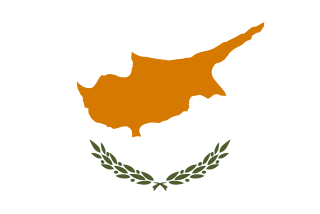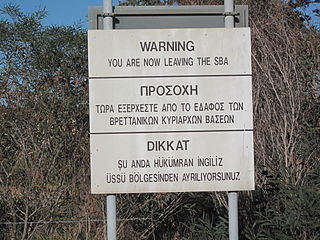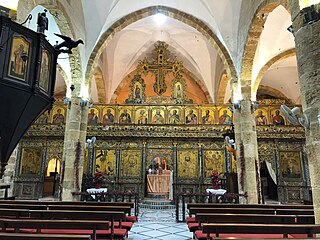Related Research Articles

Cyprus, officially the Republic of Cyprus, is an island country in the eastern Mediterranean Sea, north of the Sinai Peninsula, south of the Anatolian Peninsula, and west of the Levant. It is geographically a part of West Asia, but its cultural ties and geopolitics are overwhelmingly Southeast European. Cyprus is the third-largest and third-most populous island in the Mediterranean. It is east of Greece, north of Egypt, south of Turkey, and west of Lebanon and Syria. Its capital and largest city is Nicosia. The northeast portion of the island is de facto governed by the self-declared Turkish Republic of Northern Cyprus.

Greek is an independent branch of the Indo-European family of languages, native to Greece, Cyprus, Italy, southern Albania, and other regions of the Balkans, the Black Sea coast, Asia Minor, and the Eastern Mediterranean. It has the longest documented history of any Indo-European language, spanning at least 3,400 years of written records. Its writing system is the Greek alphabet, which has been used for approximately 2,800 years; previously, Greek was recorded in writing systems such as Linear B and the Cypriot syllabary. The alphabet arose from the Phoenician script and was in turn the basis of the Latin, Cyrillic, Coptic, Gothic, and many other writing systems.

The Greeks or Hellenes are an ethnic group and nation native to Greece, Cyprus, southern Albania, Anatolia, parts of Italy and Egypt, and to a lesser extent, other countries surrounding the Eastern Mediterranean and Black Sea. They also form a significant diaspora, with many Greek communities established around the world.

Nikephoros II Phokas, Latinized Nicephorus II Phocas, was Byzantine emperor from 963 to 969. His career, not uniformly successful in matters of statecraft or of war, nonetheless greatly contributed to the resurgence of the Byzantine Empire during the 10th century. In the east, Nikephoros completed the conquest of Cilicia and retook the islands of Crete and Cyprus, opening the path for subsequent Byzantine incursions reaching as far as Upper Mesopotamia and the Levant; these campaigns earned him the sobriquet "pale death of the Saracens".
Elizabeth Mary Jeffreys was a British scholar of Byzantium. She was Bywater and Sotheby Professor of Byzantine and Modern Greek Language and Literature, University of Oxford, and a Professorial Fellow of Exeter College, Oxford, 1996–2006.

The Byzantine Greeks were the Greek-speaking Eastern Romans throughout Late Antiquity and the Middle Ages. They were the main inhabitants of the lands of the Byzantine Empire, of Constantinople and Asia Minor, the Greek islands, Cyprus, and portions of the southern Balkans, and formed large minorities, or pluralities, in the coastal urban centres of the Levant and northern Egypt. Throughout their history, the Byzantine Greeks self-identified as Romans, but are referred to as "Byzantine Greeks" in modern historiography. Latin speakers identified them simply as Greeks or with the term Romaei.

Judith Herrin is an English archaeologist, byzantinist, and historian of Late Antiquity. She was a professor of Late Antique and Byzantine sudies and the Constantine Leventis Senior Research Fellow at King's College London.

Anna of Hungary was a Princess of Hungary and Croatia, and a Byzantine Empress by marriage to Andronikos II Palaiologos.

The official languages of the Republic of Cyprus are Greek and Turkish. The everyday spoken language (vernacular) of Greek Cypriots is Cypriot Greek, and that of Turkish Cypriots is Cypriot Turkish. For official purposes, the standard languages are used.

Byzantine studies is an interdisciplinary branch of the humanities that addresses the history, culture, demography, dress, religion/theology, art, literature/epigraphy, music, science, economy, coinage and politics of the Eastern Roman Empire. The discipline's founder in Germany is considered to be the philologist Hieronymus Wolf (1516–1580), a Renaissance Humanist. He gave the name "Byzantine" to the Eastern Roman Empire that continued after the Western Roman Empire collapsed in 476 AD. About 100 years after the final conquest of Constantinople by the Ottomans, Wolf began to collect, edit, and translate the writings of Byzantine philosophers. Other 16th-century humanists introduced Byzantine studies to Holland and Italy. The subject may also be called Byzantinology or Byzantology, although these terms are usually found in English translations of original non-English sources. A scholar of Byzantine studies is called a Byzantinist.

The Byzantine Empire, also referred to as the Eastern Roman Empire, was the continuation of the Roman Empire centered in Constantinople during Late Antiquity and the Middle Ages. The eastern half of the Empire survived the conditions that caused the fall of the West in the 5th century AD, and continued to exist until the fall of Constantinople to the Ottoman Empire in 1453. During most of its existence, the empire remained the most powerful economic, cultural, and military force in the Mediterranean world. The term "Byzantine Empire" was only coined following the empire's demise; its citizens referred to the polity as the "Roman Empire" and to themselves as "Romans". Due to the imperial seat's move from Rome to Byzantium, the adoption of state Christianity, and the predominance of Greek instead of Latin, modern historians continue to make a distinction between the earlier "Roman Empire" and the later "Byzantine Empire".

Solon J. Hadjisolomos is a Cypriot musicologist.
Nikephoros Diogenes, Latinized as Nicephorus Diogenes, was presumably a junior Byzantine emperor around 1069–1071. He was born c. 1069 to Emperor Romanos IV Diogenes and Empress Eudokia Makrembolitissa. He was elevated to junior emperor in 1070, although he lost this position when his father was overthrown in 1071. Emperor Alexios I Komnenos, after overthrowing Nikephoros III, made Nikephoros doux of Crete, and made him a general. Nikephoros conspired against him in 1094, involving numerous confidants and relatives of Alexios, including Alexios' brother, Adrianos. For this conspiracy, he was blinded, in accordance with Byzantine traditions. After this, he retired to his estates, and spent the last years of his life studying classical literature.
Hierotopy is the creation of sacred spaces viewed as a special form of human creativity and also a related academic field where specific examples of such creativity are studied. The concept and the term were developed in 2002 by Russian art-historian and byzantinist Alexei Lidov. Hierotopy accounts for the ways in which a vast array of media are used to organize sacred spaces. As an academic field, it spans the disciplines of art history, archeology, cultural anthropology, ethnology and religious studies, but it possesses an object of study and a methodology of its own. It differs from the phenomenology of the sacred insofar as it focuses on historical examples of hierotopic projects, that is, projects establishing a medium of communication between the mundane and the sacred. Though related with religious mysticism, hierotopy deals first and foremost with forms of conscious, creative activity.

Doula Mouriki was a Greek Byzantinologist and art historian. She made important contributions to the study of Byzantine art in Greece.

St Andrew's Church is a Greek Catholic (Melkite) church. Built in 1765, it is located in the old city of Acre, at Philippe Auguste street, north of the Templars tunnel in modern-day Israel. It is named after one of the twelve apostles of Jesus. The church was built on the remains of a Crusader church. The church is still used today and is known for its beautiful interior, icons, and ornate decoration.
Saint Mary the Younger was a Byzantine saint of Armenian origin, the daughter of an Armenian noble. Some details of her life, including her following after the mid-10th century, are not known for certain; the text documenting some of her most noteworthy accomplishments was most likely written after 1025. It has been suggested that the Life of Mary is a parody of Gregory of Nyssa's Life of Macrina.

Ruth Iouliani (Juliana) Macrides was a UK-based historian of the Byzantine Empire. At the time of her death, she was Reader in Byzantine Studies at the Centre for Byzantine, Ottoman and Greek Studies at the University of Birmingham. She was an expert in Byzantine history, culture and politics, particularly of the mid-later Byzantine period, and on the reception of Byzantium in Britain and Greece.
Anthony Kaldellis is a Greek and American historian and self-described Byzantinist who is Professor and a faculty member of the Department of Classics at the University of Chicago. He is a specialist in Greek historiography, Plato and Byzantine Studies. He is also the author of numerous monographs on classical antiquity and the Byzantine Empire, which have been translated into many languages. Throughout his work Kaldellis has called into question a commonly accepted view of Byzantium as an absolutist world; he considers instead the Byzantine Empire a "bottom-up monarchy", where the common people have a good share in government, since Emperors impose laws by acknowledging their customs and demands.

The coronation was the main symbolic act of accession to the throne of a Byzantine emperor, co-emperor, or empress. Founded on Roman traditions of election by the Senate or acclamation by the army, the ceremony evolved over time from a relatively simple, ad hoc affair to a complex ritual.
References
- 1 2 "Stavroula Constantinou". European Cultural Parliament. Retrieved 27 November 2017.
- 1 2 3 4 "ΣΤΑΥΡΟΥΛΑ ΚΩΝΣΤΑΝΤΙΝΟΥ" (in Greek). University of Cyprus. Retrieved 27 November 2017.
- ↑ "Court ceremonies and rituals of power in Byzantium and the medieval Mediterranean : comparative perspectives /". worldcat.org. Retrieved 27 November 2017.